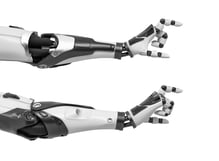What to look for in a Miniature Motor When Designing Your Next Robotic Application
Advancements in automation and artificial intelligence are driving innovation in robotics. New developments in vision systems and sensor technologies require inventive applications for robots in the medical, warehousing, security and process automaton fields. These disruptive technologies are are creating new opportunities for miniature motors in the medical, warehousing, security and process automation fields.
Mobility and Smaller Footprint.
As the trend towards robotics that can mimic hand movements grows, miniature motors have stepped up to meet the challenge. These power-dense, highly flexible and dexterous motors are the perfect fit for humanoid robots, prosthetic arms, exoskeleton and robotic grippers. Slotless motor designs, combined with efficient planetary gearboxes, offer a very powerful unit in a small package. Many

robotic applications run on battery power, so require very efficient motors (up to 90%) to provide longer running time. Certain applications require high torque at lower speeds, achievable by matching the motor with a highly efficient gearbox (up to 90%). Inefficient gearbox designs negatively affect overall system efficiencies, decreasing battery operating time, while increasing costs.
Robustness and Extended Life.
Robotic systems can take on the challenge of toxic environments and inhospitable applications. When under high temperature / pressure extremes and other hazardous conditions, a well-designed motor will provide additional life over standard motors. Motors with metal housings and flanges are well suited for harsh environments including surveillance, inspection of pipelines and sewers, power grid patrol and more. Robots in surgical applications must endure repeated high temperature and pressure cycles during the sterilization process. To match these demands, the motor design includes encapsulation of electromechanical and electronic components. The design upgrades can extend the life of the motor multiple times, allowing the surgical robot to complete many more surgeries before maintenance is required.
Safety and AnalyticsRobots, working side by side with humans, must operate safely and predictably when faced with an obstacle. High-resolution encoders provide the precision required to achieve critical positions repeatedly, so that robots do not go off track. Precision current sensors can detect inadvertent interactions with personnel, stopping the robot quickly before any damage or harm occurs. Thermistors and other temperature devices alert operators when temperature limits are about to be exceeded, enabling operations to be ceased temporarily to determine the source of the issue and corrections completed. Many robotic systems also collect various data related to work completed as well as self-diagnosis to facilitate predictive maintenance. Thermal or force sensors integrated into motors provide real-time data to quickly identify deviations in expected force levels.
It Pays to Collaborate
Portescap is a unique company developing motor, gearbox and encoder technologies to deliver the best solution for customers for advanced robotic applications. Portescap’s multi-technology offerings and collaboration expertise offer significant advantages for customers - providing several technology choices for an application, each offering specific advantages in meeting critical requirements. Portescap specialists, with decades of experience in solving the most challenging motion applications, create uniquely tailored, cost-effective robotic solutions not possible with a standard motor.
